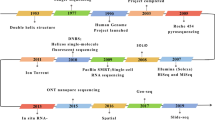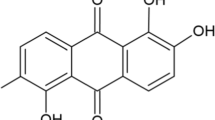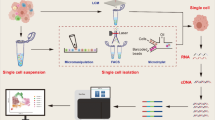Abstract
Purpose
Long intergenic non-coding RNAs (lincRNAs) are increasingly recognized as important regulators for pathogenesis and/or prognosis of breast cancer, including triple-negative breast cancer (TNBC) subtype. However, few previous studies used RNA-sequencing (RNA-Seq) technology, and none included an independent replication.
Methods
To systematically evaluate the association between expression of lincRNAs and TNBC survival, we examined lincRNA expression profiles in TNBC tissues using RNA-Seq data for 200 TNBC patients from the Shanghai Breast Cancer Survival Study (SBCSS) and Southern Community Cohort Study (SCCS).
Results
Twenty-five lincRNAs were found to be associated with overall survival (P < 0.05 and no significant heterogeneity across studies at Q statistic P > 0.1), and 61 lincRNAs were associated with disease-free survival (DFS). Among these, two lincRNAs (LINC01270 and LINC00449) were significantly associated with both worse overall survival and DFS and were expressed at significantly higher levels in tumor tissues compared with adjacent normal breast tissues (log2[Fold Change] > 0.5 and FDR < 0.05). We further evaluated the potential functions of LINC01270 and LINC00449 using in vitro functional experiments and found that siRNA-mediated knockdown of LINC01270 and LINC00449 expression significantly decreased cell viability, colony formation and cell migration ability in TNBC cells (P < 0.05).
Conclusions
Evidence from observational studies and in vitro experiments indicates that LINC00449 and LINC01270 may be prognostic biomarkers for TNBC.


Similar content being viewed by others
Data availability
The datasets generated and analyzed during the current study are available from the corresponding author on reasonable request.
References
Guttman M, Amit I, Garber M, French C, Lin MF, Feldser D, Huarte M, Zuk O, Carey BW, Cassady JP, Cabili MN, Jaenisch R, Mikkelsen TS, Jacks T, Hacohen N, Bernstein BE, Kellis M, Regev A, Rinn JL, Lander ES (2009) Chromatin signature reveals over a thousand highly conserved large non-coding RNAs in mammals. Nature 458(7235):223–227. https://doi.org/10.1038/nature07672
Preker P, Nielsen J, Kammler S, Lykke-Andersen S, Christensen MS, Mapendano CK, Schierup MH, Jensen TH (2008) RNA exosome depletion reveals transcription upstream of active human promoters. Science 322(5909):1851–1854. https://doi.org/10.1126/science.1164096
Han P, Chang CP (2015) Long non-coding RNA and chromatin remodeling. RNA Biol 12(10):1094–1098. https://doi.org/10.1080/15476286.2015.1063770
Hadjicharalambous MR, Lindsay MA (2019) Long non-coding RNAs and the innate immune response. Noncoding RNA 5(2):34. https://doi.org/10.3390/ncrna5020034
Huarte M, Rinn JL (2010) Large non-coding RNAs: missing links in cancer? Hum Mol Genet 19(R2):R152–161. https://doi.org/10.1093/hmg/ddq353
Bray F, Ferlay J, Soerjomataram I, Siegel RL, Torre LA, Jemal A (2018) Global cancer statistics 2018: GLOBOCAN estimates of incidence and mortality worldwide for 36 cancers in 185 countries. CA Cancer J Clin 68(6):394–424. https://doi.org/10.3322/caac.21492
Anders C, Carey LA (2008) Understanding and treating triple-negative breast cancer. Oncology 22(11):1233–1239 (discussion 1239-1240, 1243)
Kim J, Piao HL, Kim BJ, Yao F, Han Z, Wang Y, Xiao Z, Siverly AN, Lawhon SE, Ton BN, Lee H, Zhou Z, Gan B, Nakagawa S, Ellis MJ, Liang H, Hung MC, You MJ, Sun Y, Ma L (2018) Long noncoding RNA MALAT1 suppresses breast cancer metastasis. Nat Genet 50(12):1705–1715. https://doi.org/10.1038/s41588-018-0252-3
Xing F, Liu Y, Wu SY, Wu K, Sharma S, Mo YY, Feng J, Sanders S, Jin G, Singh R, Vidi PA, Tyagi A, Chan MD, Ruiz J, Debinski W, Pasche BC, Lo HW, Metheny-Barlow LJ, D’Agostino RB Jr, Watabe K (2018) Loss of XIST in breast cancer Activates MSN-c-met and reprograms microglia via exosomal miRNA to promote brain metastasis. Cancer Res 78(15):4316–4330. https://doi.org/10.1158/0008-5472.CAN-18-1102
Shin VY, Chen J, Cheuk IW, Siu MT, Ho CW, Wang X, Jin H, Kwong A (2019) Long non-coding RNA NEAT1 confers oncogenic role in triple-negative breast cancer through modulating chemoresistance and cancer stemness. Cell Death Dis 10(4):270. https://doi.org/10.1038/s41419-019-1513-5
Ding X, Zhu L, Ji T, Zhang X, Wang F, Gan S, Zhao M, Yang H (2014) Long intergenic non-coding RNAs (LincRNAs) identified by RNA-seq in breast cancer. PLoS ONE 9(8):e103270. https://doi.org/10.1371/journal.pone.0103270
Zhang Y, Wagner EK, Guo X, May I, Cai Q, Zheng W, He C, Long J (2016) Long intergenic non-coding RNA expression signature in human breast cancer. Sci Rep 6:37821. https://doi.org/10.1038/srep37821
Baglia ML, Cai Q, Zheng Y, Wu J, Su Y, Ye F, Bao PP, Cai H, Zhao Z, Balko J, Zheng W, Lu W, Shu XO (2014) Dual specificity phosphatase 4 gene expression in association with triple-negative breast cancer outcome. Breast Cancer Res Treat 148(1):211–220. https://doi.org/10.1007/s10549-014-3127-z
Su Y, Zheng Y, Zheng W, Gu K, Chen Z, Li G, Cai Q, Lu W, Shu XO (2011) Distinct distribution and prognostic significance of molecular subtypes of breast cancer in Chinese women: a population-based cohort study. BMC Cancer 11:292. https://doi.org/10.1186/1471-2407-11-292
Signorello LB, Hargreaves MK, Steinwandel MD, Zheng W, Cai Q, Schlundt DG, Buchowski MS, Arnold CW, McLaughlin JK, Blot WJ (2005) Southern community cohort study: establishing a cohort to investigate health disparities. J Natl Med Assoc 97(7):972–979
Guo Y, Wu J, Zhao S, Ye F, Su Y, Clark T, Sheng Q, Lehmann B, Shu XO, Cai Q (2016) RNA sequencing of formalin-fixed, paraffin-embedded specimens for gene expression quantification and data mining. Int J Genomics 2016:9837310. https://doi.org/10.1155/2016/9837310
TCGA GDC mRNA analysis pipeline. https://docs.gdc.cancer.gov/Data/Bioinformatics_Pipelines/Expression_mRNA_Pipeline/
Dobin A, Davis CA, Schlesinger F, Drenkow J, Zaleski C, Jha S, Batut P, Chaisson M, Gingeras TR (2013) STAR: ultrafast universal RNA-seq aligner. Bioinformatics 29(1):15–21. https://doi.org/10.1093/bioinformatics/bts635
Frankish A, Diekhans M, Ferreira AM, Johnson R, Jungreis I, Loveland J, Mudge JM, Sisu C, Wright J, Armstrong J, Barnes I, Berry A, Bignell A, Carbonell Sala S, Chrast J, Cunningham F, Di Domenico T, Donaldson S, Fiddes IT, Garcia Giron C, Gonzalez JM, Grego T, Hardy M, Hourlier T, Hunt T, Izuogu OG, Lagarde J, Martin FJ, Martinez L, Mohanan S, Muir P, Navarro FCP, Parker A, Pei B, Pozo F, Ruffier M, Schmitt BM, Stapleton E, Suner MM, Sycheva I, Uszczynska-Ratajczak B, Xu J, Yates A, Zerbino D, Zhang Y, Aken B, Choudhary JS, Gerstein M, Guigo R, Hubbard TJP, Kellis M, Paten B, Reymond A, Tress ML, Flicek P (2019) GENCODE reference annotation for the human and mouse genomes. Nucleic Acids Res 47(D1):D766–D773. https://doi.org/10.1093/nar/gky955
Parker JS, Mullins M, Cheang MC, Leung S, Voduc D, Vickery T, Davies S, Fauron C, He X, Hu Z, Quackenbush JF, Stijleman IJ, Palazzo J, Marron JS, Nobel AB, Mardis E, Nielsen TO, Ellis MJ, Perou CM, Bernard PS (2009) Supervised risk predictor of breast cancer based on intrinsic subtypes. J Clin Oncol 27(8):1160–1167. https://doi.org/10.1200/JCO.2008.18.1370
Ciriello G, Gatza ML, Beck AH, Wilkerson MD, Rhie SK, Pastore A, Zhang H, McLellan M, Yau C, Kandoth C, Bowlby R, Shen H, Hayat S, Fieldhouse R, Lester SC, Tse GM, Factor RE, Collins LC, Allison KH, Chen YY, Jensen K, Johnson NB, Oesterreich S, Mills GB, Cherniack AD, Robertson G, Benz C, Sander C, Laird PW, Hoadley KA, King TA, Network TR, Perou CM (2015) Comprehensive molecular portraits of invasive lobular breast cancer. Cell 163(2):506–519. https://doi.org/10.1016/j.cell.2015.09.033
Gendoo DM, Ratanasirigulchai N, Schroder MS, Pare L, Parker JS, Prat A, Haibe-Kains B (2016) Genefu: an R/Bioconductor package for computation of gene expression-based signatures in breast cancer. Bioinformatics 32(7):1097–1099. https://doi.org/10.1093/bioinformatics/btv693
NCI GDC data portal. https://portal.gdc.cancer.gov/
Mounir M, Lucchetta M, Silva TC, Olsen C, Bontempi G, Chen X, Noushmehr H, Colaprico A, Papaleo E (2019) New functionalities in the TCGAbiolinks package for the study and integration of cancer data from GDC and GTEx. PLoS Comput Biol 15(3):e1006701. https://doi.org/10.1371/journal.pcbi.1006701
Livak KJ, Schmittgen TD (2001) Analysis of relative gene expression data using real-time quantitative PCR and the 2(-Delta Delta C(T)) Method. Methods 25(4):402–408. https://doi.org/10.1006/meth.2001.1262
Wu L, Wang J, Cai Q, Cavazos TB, Emami NC, Long J, Shu XO, Lu Y, Guo X, Bauer JA, Pasaniuc B, Penney KL, Freedman ML, Kote-Jarai Z, Witte JS, Haiman CA, Eeles RA, Zheng W, the Practical CBPCCPC (2019) Identification of novel susceptibility loci and genes for prostate cancer risk: a transcriptome-wide association study in over 140,000 European descendants. Cancer Res 79(13):3192–3204. https://doi.org/10.1158/0008-5472.CAN-18-3536
Wu H, Liu Y, Shu XO, Cai Q (2016) MiR-374a suppresses lung adenocarcinoma cell proliferation and invasion by targeting TGFA gene expression. Carcinogenesis 37(6):567–575. https://doi.org/10.1093/carcin/bgw038
Love MI, Huber W, Anders S (2014) Moderated estimation of fold change and dispersion for RNA-seq data with DESeq2. Genome Biol 15(12):550. https://doi.org/10.1186/s13059-014-0550-8
Wang Y, Fu J, Wang Z, Lv Z, Fan Z, Lei T (2019) Screening key lncRNAs for human lung adenocarcinoma based on machine learning and weighted gene co-expression network analysis. Cancer Biomark 25(4):313–324. https://doi.org/10.3233/CBM-190225
Zahnow CA (2009) CCAAT/enhancer-binding protein beta: its role in breast cancer and associations with receptor tyrosine kinases. Expert Rev Mol Med 11:e12. https://doi.org/10.1017/S1462399409001033
Bentires-Alj M, Neel BG (2007) Protein-tyrosine phosphatase 1B is required for HER2/Neu-induced breast cancer. Cancer Res 67(6):2420–2424. https://doi.org/10.1158/0008-5472.CAN-06-4610
Schimmoller F, Diaz E, Muhlbauer B, Pfeffer SR (1998) Characterization of a 76 kDa endosomal, multispanning membrane protein that is highly conserved throughout evolution. Gene 216(2):311–318. https://doi.org/10.1016/s0378-1119(98)00349-7
Abou-Sharieha S, Sugii Y, Tuoya YuD, Chen L, Tokutaka H, Seno M (2009) Identification of TM9SF2 as a candidate of the cell surface marker common to breast carcinoma cells. Chin J Clin Oncol 6:1
Riba A, Emmenlauer M, Chen A, Sigoillot F, Cong F, Dehio C, Jenkins J, Zavolan M (2017) Explicit modeling of siRNA-dependent on- and off-target repression improves the interpretation of screening results. Cell Syst 4(2):182–193. https://doi.org/10.1016/j.cels.2017.01.011
Jackson AL, Burchard J, Schelter J, Chau BN, Cleary M, Lim L, Linsley PS (2006) Widespread siRNA “off-target” transcript silencing mediated by seed region sequence complementarity. RNA 12(7):1179–1187. https://doi.org/10.1261/rna.25706
Acknowledgements
We thank Regina Courtney for her help with RNA sample preparation and Dr. Mary Shannon Byers for assistance with editing and manuscript preparation.
Funding
This study was supported by grants from the US Department of Defense (DOD) Breast Cancer Research Program (DAMD 17-02-1-0607 to X.-O. Shu) and the National Institutes of Health (NIH; R01 CA118229 to X.-O. Shu, P50CA098131 to C. Arteaga, U01CA202979 to W. J. Blot and W. Zheng). Sample preparation was conducted at the Survey and Biospecimen Shared Resources, which is supported in part by the Vanderbilt-Ingram Cancer Center (P30CA068485).
Author information
Authors and Affiliations
Contributions
Conceptualization: JP, SH, QC and XS. Data curation: PB, KG, JW, TS, WJB, WZ, QC and XS. Statistical analysis: JP and HC. In vitro Experiment: SH and JW. Funding acquisition: WJB, WZ and XS. Study supervision: QC and XS. Manuscript drafting: JP and SH. Critical review and final approval: All authors.
Corresponding author
Ethics declarations
Conflict of interest
None of the authors have a conflict of interest.
Ethical approval
The study protocol was approved by the institutional review boards of Vanderbilt University and the Shanghai Municipal Center for Disease Control and Prevention.
Informed consent
All participants provided written informed consent.
Additional information
Publisher's Note
Springer Nature remains neutral with regard to jurisdictional claims in published maps and institutional affiliations.
Electronic supplementary material
Below is the link to the electronic supplementary material.
Rights and permissions
About this article
Cite this article
Ping, J., Huang, S., Wu, J. et al. Association between lincRNA expression and overall survival for patients with triple-negative breast cancer. Breast Cancer Res Treat 186, 769–777 (2021). https://doi.org/10.1007/s10549-020-06021-6
Received:
Accepted:
Published:
Issue Date:
DOI: https://doi.org/10.1007/s10549-020-06021-6




